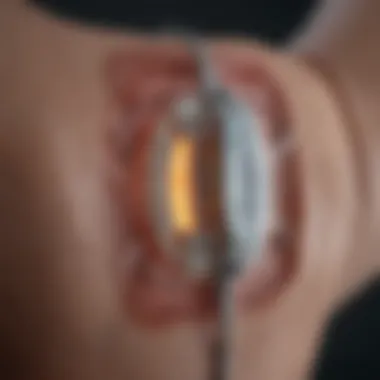TENS Implant: Mechanisms, Applications, and Future Insights


Intro
Transcutaneous Electrical Nerve Stimulation (TENS) implants are emerging as a significant tool in the field of pain management and neurological treatment. Traditional TENS therapy has primarily been used in a non-invasive manner. However, TENS implants offer the possibility of a more direct approach, potentially enhancing efficacy and patient outcomes. This article aims to shed light on the intricate mechanisms that power TENS technology, the various applications it holds in clinical practice, and the future challenges and prospects facing this innovative device.
Research Highlights
Key Findings
- Mechanisms of Action: TENS implants utilize electrical impulses to stimulate peripheral nerves, thereby altering pain perception in the brain. Studies show that they have the potential to modulate the body’s natural pain relief mechanisms, including the release of endorphins.
- Clinical Applications: TENS implants have been applied in several medical domains, from managing chronic pain conditions such as fibromyalgia to providing relief in post-operative surgical cases. The preliminary data suggests improved patient satisfaction and reduced reliance on opioid medications.
- Patient Outcomes: Early results illustrate significant enhancements in quality of life for patients with conditions like neuropathic pain and migraines. Patient feedback indicates reduced pain levels and better functional outcomes post-implantation.
Implications and Applications
TENS implants present considerable implications for both current and future medical practices. They have the potential to reduce healthcare costs by minimizing long-term dependence on pharmacological treatments. Furthermore, the integration of TENS technology into telemedicine could expand access for patients in remote areas, providing essential pain management resources.
While still in the early stages of adoption, TENS implants signify a shift toward innovative pain management strategies that prioritize patient autonomy and quality of life.
Methodology Overview
Research Design
The research surrounding TENS implants usually follows a multi-phased approach, involving both pre-clinical trials and extended clinical application studies. The aim is to assess both immediate and long-term effects of the implants in various patient populations.
Experimental Procedures
In most studies, participants are selected based on specific inclusion criteria related to their pain conditions. Initial assessments often involve baseline pain levels using established scoring systems. Post-implantation, the patients are monitored through follow-up assessments to gauge pain reduction, functional improvement, and any side effects experienced.
Closure
As TENS implants continue to develop, their growing presence in the medical field highlights a commitment to exploring modern techniques in pain management. Ongoing research will be critical to understanding their full potential, paving the way for innovations that enhance patient care.
Prelims to TENS Implants
The topic of TENS implants is increasingly important in medical discussions surrounding pain management and rehabilitation strategies. The relevance of these implants stems from their ability to provide personalized and effective treatment options for patients suffering from various types of pain. With the rise in chronic pain conditions and the limitations of traditional pharmacological treatments, TENS implants offer a new avenue for relief without the associated risks of medication side effects.
TENS, or Transcutaneous Electrical Nerve Stimulation, involves the use of electrical impulses to modulate pain signals before they reach the brain. The implants, which deliver these impulses continuously or intermittently, stand to improve quality of life for many individuals, particularly those with chronic conditions. The versatility of TENS technology allows for applications beyond pain management, including rehabilitation and neurological conditions, making this an expansive field ripe for exploration.
In this article, we will delve into the mechanisms that govern TENS implants, their applications across different medical scenarios, and their future potential. The key elements to be discussed include the operational principles of nerve stimulation, clinical applications, and emerging trends in technology and patient care. By investigating these aspects, we aim to provide a thorough understanding of what TENS implants can offer to both patients and medical professionals alike.
Definition of TENS Technology
TENS technology refers to the method of using electrical impulses to modulate nerve activity in order to alleviate pain. By placing electrodes on the skin's surface, electrical impulses mimic natural nerve signals. This process can help in blocking pain signals from reaching the brain, thus providing relief. TENS is notable for being a non-invasive method with an adjustable level of stimulation, allowing healthcare providers to tailor treatment to individual patient needs.
Historical Background of TENS
The development of TENS technology has its roots in early electrical stimulation research. In the 1960s, researchers began to investigate the effects of electrical stimulation on nerve pathways and pain perception. This research led to the first commercially available TENS devices in the late 1970s. Since then, TENS technology has evolved significantly, incorporating digital controls, programmable settings, and even implantable devices that deliver stimulation directly to the target areas within the body. As clinical evidence supporting TENS grew, so did its acceptance in medical practice, making it a standard approach for various pain management protocols.
Mechanisms of Action
Understanding the mechanisms of action for TENS implants is fundamental in grasping how they alleviate pain and enhance patient comfort. These mechanisms involve complex interactions within the nervous system that ultimately lead to significant improvements in patient outcomes. By decoding these processes, professionals can better appreciate the utility of TENS as a treatment modality and inform clinical decisions.
Nerve Stimulation Principles
TENS implants operate primarily on the principle of nerve stimulation. They deliver low-voltage electrical impulses to specific nerves through electrodes placed near the affected area. This stimulation affects the nervous system in two significant ways:
- Pain Gate Control Theory: According to this theory, stimulation can block pain signals from reaching the brain. When the nociceptive pathways are overwhelmed by the electrical impulses, it creates a 'gate' effect, preventing pain signals from being transmitted.
- Endogenous Opioid Release: The electrical impulses can also induce the release of endorphins, the body's natural pain relief chemicals. This release contributes to a decrease in overall pain perception and enhances the feeling of well-being.


Pain Modulation Pathways
Pain modulation pathways are integral to understanding how TENS implants function to alleviate discomfort. TENS stimulates not only sensory nerves but also engages various neural pathways involved in pain modulation.
- Ascending Pathways: TENS activates sensory neurons that ascend to the brain, effectively altering the way pain is processed.
- Descending Modulatory Pathways: The stimulation also encourages descending pathways that inhibit pain transmission at the spinal cord level.
- Influence on Neurotransmitters: TENS has been shown to influence the release of neurotransmitters essential in pain regulation, including serotonin and norepinephrine, contributing to mood improvements alongside pain relief.
Electrophysiological Responses
Electrophysiological responses play a crucial role in how TENS implants provide therapeutic benefits. When the electrodes deliver electrical impulses, several physiological changes occur in the body:
- Repolarization of Nerve Cells: Stimulation leads to a rapid repolarization of nerve cells, which can alter their ability to transmit pain signals.
- Altered Action Potentials: The electrical currents can modify action potentials, resulting in changes in how pain is perceived.
- Network Effects: The interaction of these impulses leads to network effects spanning across various systems within the body. The consequence is a collaborative approach to pain relief involving both peripheral and central nervous systems.
Thus, the true potential of TENS implants lies in their ability to engage multiple physiological mechanisms, tailoring their effects to individual patients and conditions.
Applications of TENS Implants
The applications of TENS implants are critical in the context of medical treatment and pain management. These devices operate on the principle of providing relief through electrical stimulation, which has implications for various patient populations and conditions. Understanding these applications can help clinicians select appropriate management strategies, tailor treatment plans, and achieve improved patient outcomes.
Chronic Pain Management
Chronic pain is a significant health issue affecting millions globally. TENS implants have emerged as an effective alternative for individuals who have not responded adequately to traditional analgesics or other treatments. The mechanism involves blockade of pain signals at the spinal cord level and the release of endorphins, creating a dual approach to pain relief.
Research indicates that TENS can reduce reliance on opioids, thereby minimizing associated side effects. Patients often report greater mobility and quality of life with consistent use of these devices. Moreover, as the devices are relatively easy to use and non-invasive, they present a compelling option for long-term pain management without the risks of invasive procedures.
Postoperative Pain Control
TENS implants play a pivotal role in postoperative pain management. After surgical procedures, patients often experience significant discomfort, which can hinder recovery. Effective pain management strategies are crucial, as they facilitate rehabilitation and expedite return to normal activities. TENS devices can help alleviate postoperative pain by providing localized stimulation around the surgical site.
Studies have shown that integrating TENS implants into postoperative protocols can lead to reduced pain scores and decreased need for systemic analgesics. This not only benefits the patient’s comfort levels but also reduces hospital stays and healthcare costs. The transient nature of TENS-based pain modulation aligns well with recovery goals following surgery.
Neuropathic Pain Treatment
Neuropathic pain, arising from nerve damage or dysfunction, poses unique challenges in pain management. Traditional analgesics often show limited efficacy for this type of pain. TENS implants have gained attention for their specific utility in addressing neuropathic pain syndromes, including diabetic neuropathy and postherpetic neuralgia.
The ability of TENS to modulate nerve signaling highlights its potential as a first-line treatment option for these conditions. By directly addressing the pathophysiological mechanisms at play, TENS provides a tailored approach that enhances pain control. Furthermore, patients suffering from neuropathic pain frequently report improved function and reduced discomfort from consistent TENS use.
Applications in Rehabilitation
The role of TENS implants in rehabilitation extends beyond pain management. These devices can enhance rehabilitation outcomes for a variety of conditions, including musculoskeletal injuries and neurological disorders such as stroke. By facilitating pain relief, TENS allows patients to engage more fully in their rehabilitation exercises.
Additionally, TENS has been shown to promote motor control and muscle activation in patients, contributing to recovery. In this context, TENS operates not only as a pain relief tool but also as an adjunct therapy to improve functional recovery. The synergy between pain management and rehabilitation underscores the multifaceted utility of TENS implants in clinical practice.
"TENS implants represent a novel approach in the management of pain and various neurological conditions, bridging the gap between relief and functional recovery."
The applications of TENS implants underline their significance in modern pain management and rehabilitation strategies. This multifactorial approach addresses diverse patient needs, enhancing their quality of life while promoting healing and recovery.
TENS Implant Procedures
The procedures involved in TENS implantations are essential for ensuring the effectiveness of this innovative treatment for pain management and neurological conditions. Proper procedures can result in successful pain relief for patients and a better quality of life. This section will detail the crucial stages of TENS implant procedures, including pre-operative assessments, implantation techniques, and post-operative care. Each element is vital as it lays a foundation for the overall success of the TENS device.
Pre-Operative Assessment
Before undergoing TENS implant surgery, a comprehensive pre-operative assessment is critical. This evaluation typically involves a thorough medical history review, physical examination, and diagnostic tests to ascertain the patient’s suitability for the procedure. The aim is to identify contraindications and potential complications that may arise during or after the implantation.
An important aspect of the assessment includes evaluating the type and source of pain. Understanding whether the pain is chronic, postoperative, or neuropathic can influence the decision to proceed with TENS implants. Furthermore, psychological evaluations may also be conducted to gauge the patient's expectations and concerns regarding pain management.
In summary, a meticulous pre-operative assessment can help clinicians make informed decisions and customize the treatment plan to the specific needs of each patient. This step is crucial in improving the patient's chances for a successful outcome following the implantation.


Implantation Techniques
The techniques used to implant TENS devices may vary based on the specific technology and the clinical objectives. Generally, the procedure is performed under local anesthesia. Surgical techniques may include the insertion of leads into specific locations near the spinal cord or peripheral nerves depending upon the patient's pain profiles.
Surgeons often use fluoroscopic guidance or ultrasound to ensure accuracy during the implantation. These techniques help minimize damage to surrounding tissues and enhance the positioning of electrodes for optimal effectiveness in pain relief.
Several factors influence the choice of implantation technique. These factors can include:
- Location of pain: TENS implants are tailored to address different pain sites.
- Patient anatomy: Individual anatomy can affect the approach taken by the surgical team.
- Device specifications: Different TENS manufacturers may have specific guidelines for implantation.
Choosing the right technique is paramount in optimizing the performance of the TENS device. Well-executed implantation can lead to improved patient outcomes.
Post-Operative Care
After the TENS implant procedure, proper post-operative care is essential for ensuring recovery and device functionality. Patients may experience mild discomfort following surgery, which is generally manageable with medication. Centers often provide guidelines on how to care for the site, including recommendations on wound care, bathing, and physical activity restrictions.
It is also important for patients to monitor for any adverse effects. This includes looking out for signs of infection, unusual pain, or device malfunction. Any concerns should be reported promptly to the healthcare provider to address potential issues before they escalate.
Additionally, follow-up appointments may be scheduled to assess the positioning of the device, adjust stimulation settings, and review pain levels.
Overall, effective post-operative care not only aids the healing process but also maximizes the benefits of the TENS implant. By ensuring patients are well-informed and monitored, healthcare providers can help improve patient outcomes significantly.
Clinical Evidence and Effectiveness
The section on Clinical Evidence and Effectiveness is crucial for understanding the impact of TENS implants in the medical realm. Evidence-based insights help establish the legitimacy of TENS treatment and its appropriate application in various clinical scenarios. These aspects not only enhance credibility but also guide medical professionals in making informed decisions regarding patient care. Comprehensive reviews of current research findings, patient outcomes, and comparative effectiveness against other treatments form the backbone of this discussion.
Current Research Findings
Recent studies on TENS implants illustrate their increasing acceptance within pain management practices. Research showcases the versatility of TENS in addressing chronic pain conditions, with many patients reporting significant relief. A systematic review published in the Journal of Pain Research outlines multiple randomized controlled trials demonstrating the efficacy of TENS in various patient demographics. Moreover, findings suggest that TENS can be beneficial for neuropathic pain, which is often resistant to conventional pain treatments.
Research also highlights the advances in technological integration, where modern TENS devices are equipped with programmable settings to tailor stimulation according to individual patient needs. The continuous development in TENS technology persuades the medical community regarding its potential future applications, including usage in different chronic pain syndromes such as fibromyalgia and diabetic neuropathy.
Patient Outcomes and Reviews
Patient testimonials and reviews play a significant role in assessing the overall effectiveness of TENS implants. Surveys conducted among patients using TENS technology indicate a high satisfaction rate. Many patients experience enhanced quality of life due to reduced pain levels, better mobility, and improved physical function. According to a recent survey, approximately 70% of patients reported a noticeable decrease in their pain scores after using TENS therapy, reinforcing the evidence obtained through clinical studies.
Additionally, longitudinal studies focusing on patient outcomes demonstrate not only the short-term relief provided by TENS implants but also their sustainability over time. Some patients have reported lasting pain relief even after discontinuing the use of the device. However, it's essential to consider varying factors among different patients, which can affect outcomes. These might include the duration of the pain condition, individual pain thresholds, and adherence to TENS therapy protocols.
Comparative Studies with Other Treatments
Comparative studies examining TENS implants against other pain management modalities offer insightful perspectives on its effectiveness. Research documents emerging comparisons with pharmacological treatments, physical therapy, and other non-invasive pain management techniques. For instance, a study published in Pain Medicine found that TENS was equally effective as opioids for managing postoperative pain but with a significantly lower risk of adverse effects.
Furthermore, when compared with invasive methods like nerve blocks or surgical interventions, TENS therapy often emerges as a safer and less complex option. Patients demonstrated fewer side effects and were able to resume regular activities much quicker when utilizing TENS. However, it's crucial to recognize that while TENS may be superior for certain pain types, it may not replace all treatment modalities, thus indicating that a multidisciplinary approach often yields the best outcomes in pain management.
"Understanding the evidence surrounding TENS not only boosts patient confidence but also empowers clinicians to advocate for its use in appropriate clinical contexts."
In summary, examining the clinical evidence and effectiveness of TENS implants provides a comprehensive view of their role in pain management. The integration of research findings, patient experiences, and comparative studies reinforces the utility of TENS technology while paving the way for further exploration in both clinical practice and future innovation.
Challenges and Limitations
Understanding the challenges and limitations of TENS implants is crucial for comprehending their role in pain management and neurological treatments. While TENS technology presents various benefits, it also comes with specific obstacles that require careful consideration. These include patient selection criteria, potential adverse effects, and technological limitations. Each of these factors can influence the effectiveness and safety of TENS implants. Therefore, assessing these aspects is essential for both practitioners and patients when considering this therapeutic option.
Patient Selection Criteria
The effectiveness of TENS implants is largely determined by appropriate patient selection. Not all individuals are ideal candidates for this type of therapy. Healthcare providers must perform thorough pre-operative assessments to determine if a patient will benefit from TENS implantation. Key factors in this evaluation may include:


- Type of Pain: Patients suffering from certain chronic pain conditions may respond better to TENS than others.
- Medical History: A patient's overall health and previous treatments must be considered. Certain conditions could contraindicate the use of TENS.
- Psychological Factors: Mental health conditions can influence pain perception and treatment efficacy.
- Age and Lifestyle: Younger patients or those with active lifestyles may experience results differently when compared to older individuals.
It is vital that medical professionals ensure the right profiles for potential patients to maximize the benefits of TENS technology while minimizing complications.
Adverse Effects and Risks
Like any medical procedure, TENS implants carry the risk of adverse effects. Awareness and management of these effects are essential to safeguard patient health. Some common adverse effects include:
- Skin Irritation: The placement of electrodes can lead to skin reactions in some patients.
- Discomfort and Pain: While TENS is intended to alleviate pain, the stimulation itself can sometimes cause discomfort during initial use.
- Infection Risks: Surgical implantation involves potential risks of infection at the insertion site.
Despite these risks, many patients find that the benefits of TENS implants outweigh these drawbacks. However, it is essential for practitioners to discuss these possibilities with patients during the consent process. Monitoring after implantation can help identify and address any complications swiftly.
Technological Limitations
Despite advancements in TENS technology, some limitations continue to exist. These technological barriers can hinder the overall effectiveness of TENS implants:
- Device Limitations: Current devices may have limited programming capabilities, restricting personalization for individual patients.
- Battery Life: Implants require regular monitoring and replacement of battery units, which can be inconvenient.
- Integration Issues: Compatibility with other treatments or therapies is sometimes lacking, which can complicate comprehensive pain management strategies.
In summary, while TENS implants offer considerable potential in treating pain and neurological conditions, it is important to understand the challenges and limitations associated with their use. Awareness of patient selection, risks involved, and existing technological constraints allows for informed decisions, enhancing patient safety and treatment outcomes.
Future Directions of TENS Technology
The exploration of future directions for TENS technology is pivotal in enhancing its capacity and expanding its applications in pain management and neurology. As medical technology progresses, the scope for TENS implants continues to grow. This section delves into several critical aspects influencing the evolution of TENS implants.
Innovations in Device Design
Device design is a crucial element in the future of TENS technology. Advances in materials science and electronics have led to the development of smaller, more efficient implants. Newer devices focus on user comfort and placement flexibility. For instance, developments in wireless technology eliminate cumbersome wires, ensuring greater mobility for patients. These innovations also allow for adjustable settings, enabling personalized pain relief without the need for frequent medical visits.
Furthermore, integration with smartphone applications is emerging. Patients can remotely monitor and modify their therapy parameters, which enhances user engagement. Such innovations may improve adherence to treatment regimens and overall patient satisfaction.
Integration with Other Therapies
The future also points towards a multidimensional approach, where TENS implants work in conjunction with other therapeutic modalities. This integration may enhance overall care. For instance, combining TENS with pharmacological approaches could provide a synergistic effect, resulting in superior pain relief compared to traditional methods.
Moreover, technique advancements like multisensory stimulation may be explored. By incorporating therapies such as physical rehabilitation or psychological support, TENS can serve as a part of a holistic treatment regimen. This idea finds support in current studies indicating improved outcomes when combining modalities rather than isolating one approach.
Regulatory and Ethical Considerations
As TENS implants become more sophisticated, regulatory oversight will be critical. Manufacturers must ensure rigorous testing and compliance with established medical standards. The incorporation of technology brings new ethical questions, such as data privacy, especially with the potential for remote monitoring.
Moreover, patient consent becomes essential when utilizing smart TENS devices. Users must understand how their health data may be used and shared. A clear framework to govern these devices will not only protect users but also boost confidence in the technology.
"Future research should prioritize both technological advancement and ethical frameworks to ensure safe and effective use of TENS implants."
Ending
In the realm of pain management and neurological treatment, TENS implants signify a transformative approach. This technology not only harnesses the natural mechanisms of the body's nervous system but also provides an alternative to conventional pain relief methods. As the article expands upon, understanding Transcutaneous Electrical Nerve Stimulation (TENS) is critical for healthcare professionals seeking innovative solutions for challenging pain management scenarios.
Summary of Key Findings
TENS implants have been shown to effectively alleviate chronic pain and assist in postoperative care. By interfacing with the nervous system, they modify pain signals before they reach the brain, thus altering the perception of pain. Key points include:
- Nerve Stimulation: TENS technology targets specific nerves, providing regional pain relief.
- Pain Modulation Pathways: The devices engage various biological pathways that are involved in the body’s pain processing systems.
- Clinical Applications: The use of TENS in chronic pain, postoperative settings, and rehabilitation has demonstrated significant benefits in improving the quality of life for patients.
The evidence gathered reinforces the reliability of TENS implants in clinical scenarios. The growing body of research highlights their effectiveness, offering a promising trajectory for the future of pain management.
Implications for Clinical Practice
For clinicians and healthcare practitioners, the implications of integrating TENS implants into treatment routines are profound. Specifically, it drives home the need for:
- Personalized Treatment Plans: The diverse responses of patients to TENS technology underline the necessity for tailored approaches in pain management.
- Continued Education: Awareness and skill enhancement regarding TENS operations are essential for practitioners to optimize patient outcomes.
- Research and Development: Ongoing exploration into TENS technology can lead to further innovations, improving device efficacy.
TENS implants are not simply a trend but represent a significant tool in modern medicine. Acknowledging their role can enhance therapeutic strategies, offering relief to patients who suffer from complex pain conditions. Addressing the specific needs of patients will pave the way for their broader application in clinical settings.



